Common Name(s): African mahogany, khaya, acajou d’Afrique
Scientific Name: Khaya spp., (primarily A. anthotheca and A. ivorensis; see notes below)
Distribution: Tropical Africa
Tree Size: 100-200 ft (30-60 m) tall,
3-6 ft (1-1.8 m) trunk diameter
Average Dried Weight: 33.9 lbs/ft3 (545 kg/m3)
Specific Gravity (Basic, 12% MC): 0.46, 0.54
Janka Hardness: 850 lbf (3,800 N)
Modulus of Rupture: 11,730 lbf/in2 (80.9 MPa)
Elastic Modulus: 1,410,000 lbf/in2 (9.72 GPa)
Crushing Strength: 6,570 lbf/in2 (45.3 MPa)
Shrinkage: Radial: 3.4%, Tangential: 5.7%,
Volumetric: 9.3%, T/R Ratio: 1.7
Color/Appearance: Heartwood ranges from pale pink to a deeper reddish brown, sometimes with streaks of medium to dark reddish brown. Colors darken with age. Quartersawn surfaces exhibit a ribbon-stripe appearance.
Grain/Texture: Grain is straight to interlocked, with a medium to coarse texture. Good natural luster and a high degree of chatoyancy.
Rot Resistance: Rated as moderately durable; moderate to poor insect/borer resistance.
Workability: Generally easy to work, though tearout can be a problem if the grain is interlocked. May stain and react with iron-based fasteners in damp conditions. Glues, turns, and finishes well.
Odor: No characteristic odor.
Allergies/Toxicity: Although severe reactions are quite uncommon, African mahogany has been reported as a sensitizer. Usually most common reactions simply include eye and skin irritation. See the articles Wood Allergies and Toxicity and Wood Dust Safety for more information.
Pricing/Availability: Available in a variety of lumber sizes, as well as plywood and veneer. Prices are moderate for an imported hardwood.
Sustainability: African mahogany is listed in CITES Appendix II under the genus-wide restriction of all Khaya species from Africa. Additionally, all the primary Khaya species of African mahogany are on the IUCN Red List. They are each listed as vulnerable due to a population reduction of over 20% in the past three generations, caused by a decline in its natural range, and exploitation.
Common Uses: Veneer, plywood, turned items, furniture, boatbuilding, and interior trim.
Comments: There are currently five accepted Khaya species, four of which are harvested and sold as African mahogany. The fifth species, K. madagascariensis, is native to Comoros and northern Madagascar and yields mahogany-like wood, but isn’t commonly exported.
Of the four commercial species, there is considerable variation in density and heartwood color. The two lightest species, K. ivorensis and K. anthotheca, are represented here on this page. The heaviest species, K. senegalensis, is sometimes called dry zone mahogany and has markedly higher density and has been given its own entry. Lastly, K. grandifoliola occupies a middle-ground in terms of density, sometimes being mixed and sold with the former two lighter species, and sometimes grouped with the heavier K. senegalensis.
According to Plant Resources of Tropical Africa,[1]Louppe, D., Oteng-Amoako, A. A., & Brink, M. (2008). Plant Resources of Tropical Africa 7 (1). Timbers 1. PROTA foundation. the average specific gravity of each of the commercial species at 12% moisture are as follows:
- K. ivorensis—0.52
- K. anthotheca—0.58
- K. grandifoliola—0.69
- K. senegalensis—0.76
Botanically, Khaya is a part of the Meliaceae family, which not only includes mahoganies, but also sapele (Entandrophragma cylindricum), Spanish cedar (Cedrela odorata), and a host of other commercial species. Considered to be a valid substitute for Honduran mahogany (Swietenia macrophylla), otherwise known as ‘genuine mahogany’—though the African species sometimes lack the deeper reddish brown color and durability that’s common for true mahogany in the Swietenia genus.
Images: Drag the slider up/down to toggle between raw and finished wood. The first sample shows a typical flatsawn piece, while the second sample shows quartersawn grain.
A special thanks to Steve Earis for providing the turned photo of this wood species.
Identification: See the article on Hardwood Anatomy for definitions of endgrain features.
Porosity: diffuse porous
Arrangement: solitary and radial multiples
Vessels: large to very large, very few; dark brown to nearly black deposits occasionally present
Parenchyma: vasicentric, and occasionally banded (marginal)—though marginal parenchyma isn’t typical for Khaya species
Rays: medium to wide; normal spacing
Lookalikes/Substitutes: Very commonly confused with the New World mahoganies in the Swietenia genus. However, Khaya species will very frequently lack maringal parenchyma bands. For more information, see the article Mahogany Mixups.
Notes: Although there is a subtle gradation in density between the various Khaya species, they can’t be reliably separated on the basis of anatomy.
Related Content:

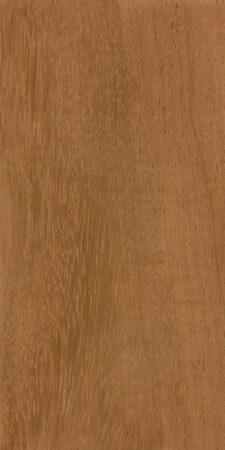
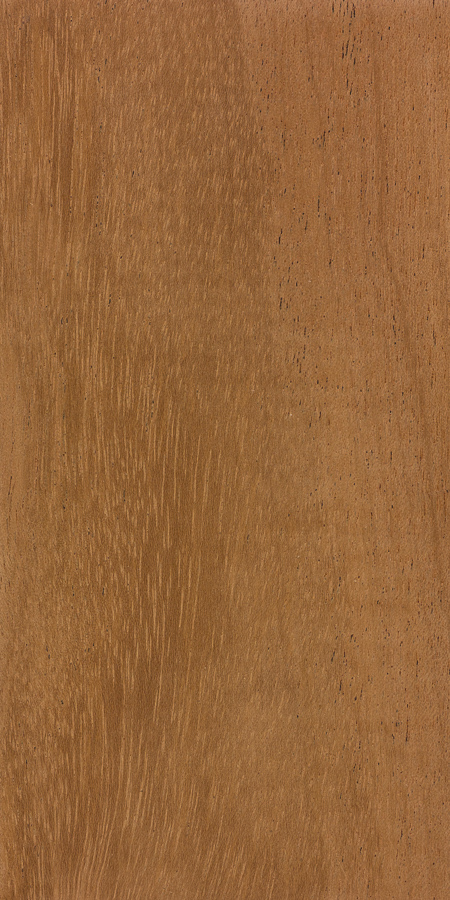
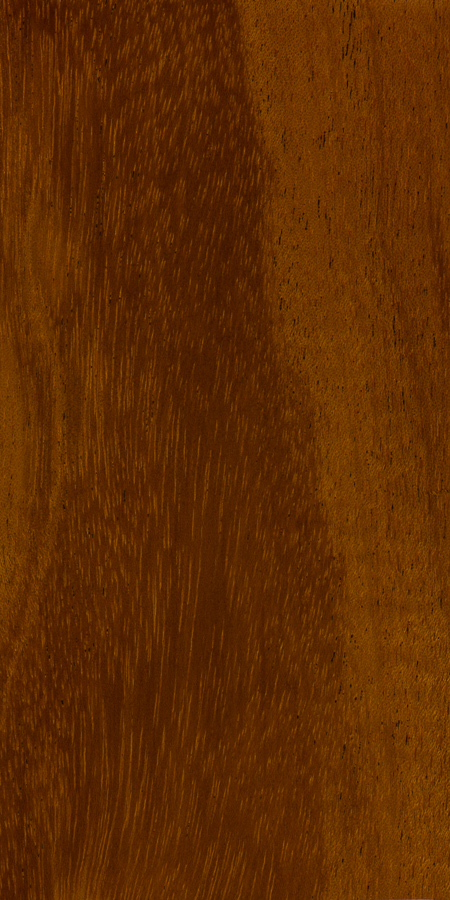
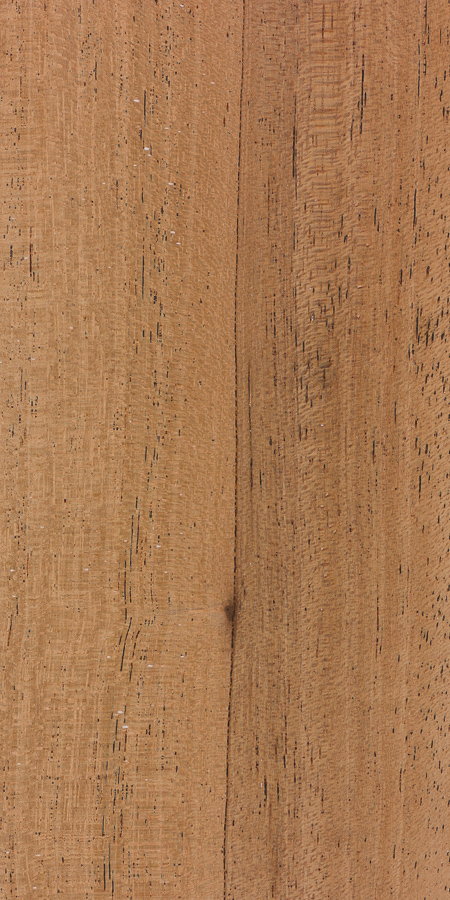
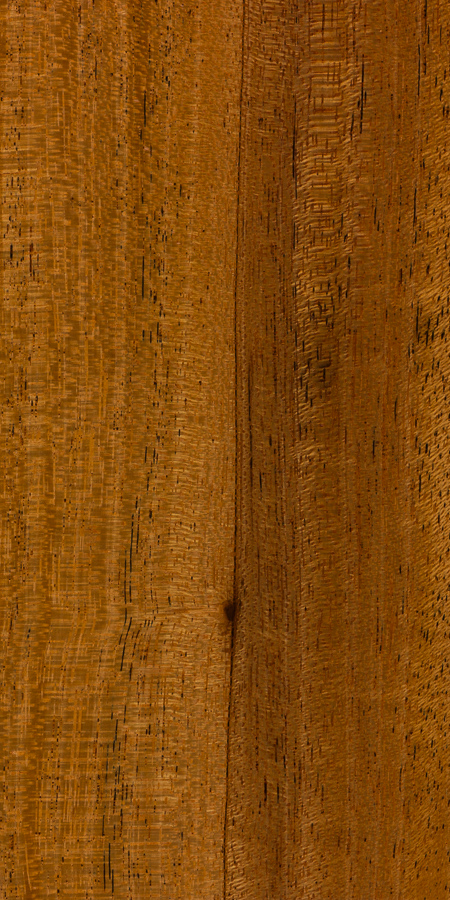
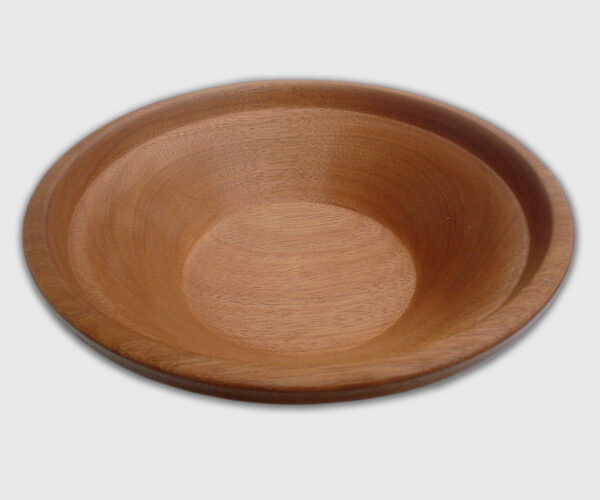
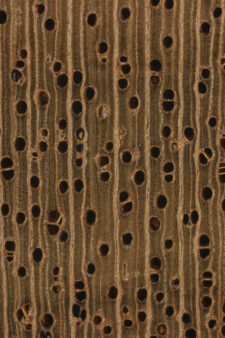

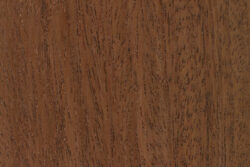
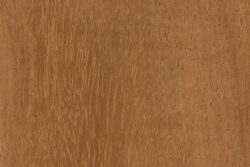
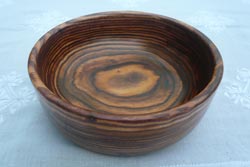

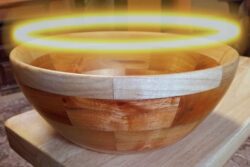


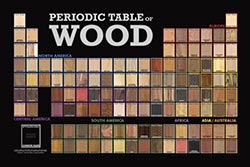




does anyone have a kiln drying schedule for 8/4 Khaya? lumber is testing 22%
How long does the African Mahogany take to completely dry? Is there anything we can do to speed up the process?
A turned bowl from African mahogany
I Have African mahogany exterior doors That have been exposed to the Sun for 12 years Sanding on them only makes them redder when I’m looking for a light Brown anybody have any ideas
In my experience, most oil finishes (like a natural watco danish oil) darken african mahogany.
I have pieces of African mahogany the color of hay, dark chocolate, and clay. Your mahogany just isn’t light brown. Unless you were the one who first installed them and remember the color. In that case take a core sample from the bottom of the door and see how far in the darkening goes to see how much you would need to sand.
I am making neck assemblies for violins and will need to know if this would will be hard enough to sustain long use of violin pegs. Violins necks are usually made of hard maple and I have a lot of mahogany I think it’s African mahogany and would like to know if anyone has used them for this purpose and also what is the hardness of mahogany versus Hard maple?
In Europe, it’s not made of hard maple but of (curly) sycomore maple, which isn’t that hard. Maybe that could help you…
I use it for guitar necks successfully
It is not nearly as hard or as stiff as hard maple. The “sycamore maple” mentioned below may be something like london plane tree (which is either a maple family wood or a hybrid). That is also harder than khaya. Khaya is somewhat coarse grained (it’s very musical, though) and can splinter much more easily than honduran mahogany. I’ve made guitars out of both and made guitar necks out of curly hard maple – khaya and honduran (honduran and cuban can both vary a lot in density) are not similar to hard maple. I think you will get a different… Read more »
I have used khaya for several fiurniture projects as a substitute for “true” mahogany. I’ve turned it for columns and finials, and have carved it for ball and claw feet and relief carvings. This wood is tricky, particularly for carving. That pretty ribbon grain presents real problems for a carver. There are areas where it carves beautifully, with consistent density and even grain. Then there are areas that are “chippy” and don’t carve well from any direction. They provide a wonderful opportunity to perfect ones slicing cut. The end result is usually well worth the frustration but know going in… Read more »
I used mahogany to trim out 4 cedar exterior pergola posts. I want to know if the mahagony will turn gray over time as the posts have? The wood was not sealed. If not can they be stained to a gray tone? thanks.